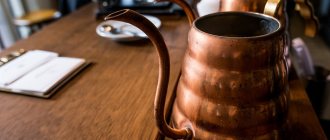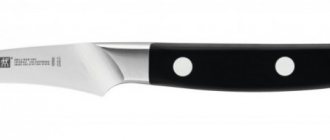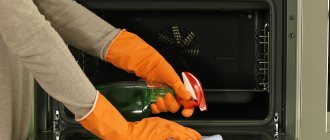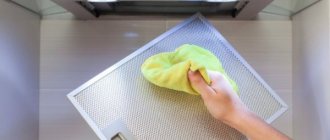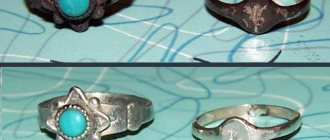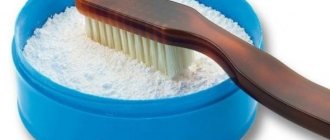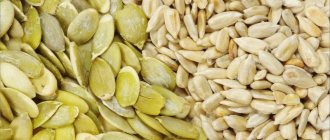How to clean copper? The relevance of this issue is explained by the fact that products made from this metal have been used by humanity for many centuries. For a long time, the value of this metal was so high that it was equal to gold. The development of technology has led to the fact that it was possible to significantly reduce the cost of copper production. This made it possible to make not only jewelry from this metal, but also dishes and interior items. The high popularity of this metal and alloys based on it is explained not only by its decorative effect, but also by its unique characteristics - high ductility, thermal conductivity, corrosion resistance, etc.
No one wants to use oxidized copper cookware.
Why do copper cookware need to be cleaned regularly?
Copper is one of the metals that can tarnish and oxidize.
For prevention, each time after using kitchen utensils, they must be thoroughly washed and wiped dry, and also avoid direct exposure to direct sunlight.
Regular cleaning will promptly eliminate the formation of plaque and the release of toxic substances.
This regular maintenance will extend the life of the copper.
How to clean copper from green deposits?
Green plaque on copper releases toxins and must be removed. Not all means can cope with its elimination.
There are several ways to remove corrosive plaque:
- The carbonated drink “Coca-Cola”, due to the presence of phosphoric acid in it, will clean and get rid of any contamination, especially green deposits. Pour this sweet fizzy drink into a small glass container and place a pot or frying pan in it for several days. This is a very original and at the same time effective method;
- ethyl alcohol mixed with turpentine and oxalic acid will also cope with green plaque. It is enough to saturate a soft sponge or rag with this liquid and apply it to the contaminated surface;
- Apply white chalk mixed with kerosene to a mushy state to the area of contamination or plaque formation. This is a great way to rub and add shine to a copper piece.
How to clean copper utensils from blackness?
Black plaque is also considered toxic. Requires mandatory elimination. However, such kitchen utensils can no longer be used for cooking.
To help get rid of blackness:
juice from half a lemon will remove the blackness if you rub it on the product, then rinse under the tap and wipe dry. If you don’t have lemon at home, you can replace it with citric acid, diluted with water to a paste.
hot soap solution diluted in a container. It is enough to immerse the dishes in it for a short amount of time. Then rinse lightly under running water and wipe dry.
with an ammonia solution . This procedure only needs to be carried out with caution, always in the open air to prevent poisoning from ammonia fumes. It is enough just to wet the sponge and wipe the product with it.
How to clean copper dishes from white deposits?
The white coating formed due to oxidation must be removed.
Several proven and reliable methods will help you quickly deal with it:
Tomato paste or ketchup, due to its high acid content, is good to use to remove white deposits and to give copper a reddish tint. It is enough to mix two tablespoons of paste with one tablespoon of salt and apply the resulting mixture to the product for 10 minutes with a sponge. Then rub in a circular motion over all the outer walls, remove the residue with a paper napkin.
glass of any fermented milk product , it is best to use sour milk, mix with 1 tablespoon of salt, soak a piece of flannel cloth or microfiber cloth with the resulting mixture. Rub the surface until the white coating is completely removed.
amidosulfuric acid , used for heavily ingrained plaque. When using it, it is important to follow safety precautions. This powder is quite aggressive, but quickly cleanses and adds shine to copper.
Cleaning copper with ammonia
Soak a rag in ammonia and apply it to the copper product. Then wipe with a clean rag to remove the ammonia. For a better effect, chalk chips are added to the alcohol. It mechanically scrubs and absorbs dirt.
Vaseline oil
Small specimens can be cleaned with oil. Vaseline is most suitable for this purpose. Before cleaning an antique copper coin, place a container of oil on the tile. To clean a coin, place it in a boiling oil liquid over low heat. In this way, you can quickly get rid of stains, rust and oxides on a collectible item. The oil has a very high boiling point, which speeds up the procedure. At the end of the process, the item is washed with ethyl alcohol.
Soda solution
You can use soda solutions on low-quality old objects that have good resistance to destruction. Before cleaning copper coins at home, add baking soda (2 tbsp) to a bowl and add plain water (5 tbsp). The resulting consistency after mixing should look like a slurry. This mass is applied to the surface of the product with small rubbing movements. Processing time will depend on the degree of contamination of the items and may take several weeks. You can speed up the procedure with additional brushing with a toothbrush. After the process is completed, the items are washed with running water and dried.
After cleaning your items at home, you need to dry them properly. For these purposes, paper towels are suitable, which should be folded in several layers and covered with them on both sides of the product. It is recommended to use only soft towels to avoid damaging an antique item or coin. Drying can be carried out using a drying cabinet heated to 100 °C. To slow down oxidative processes, the product is periodically wiped with crumpled black and white newspaper. Everyone has to choose how to clean copper items at home individually.
"Coca Cola"
Children's favorite drink can rid the surface of copper items of greenery, as well as other contaminants. To do this, coins are placed in a small container and filled with sweet fizzy drink. It is advisable to use glass containers. After a few days, all dirt and oxides will be successfully cleaned and things will acquire an attractive appearance. This effect occurs due to the presence of orthophosphoric acid in the effervescent drink. It is this that helps clean the metal from oxidizing greens and other contaminants. To speed up the process, you can place the container on a warm radiator or use another source of constant heating. This is the most original way for those interested in how to clean copper at home.
Cleaning copper with phosphoric acid
To clean copper from rust, phosphoric acid is used. The product is dipped in a 15–30% solution of orthophosphoric acid and applied with a brush or spray. Leave for a few minutes to take effect. Clean off plaque with a cotton cloth. If necessary, repeat the procedure.
Citrus
For convenience, you can cut off half of a citrus fruit and rub it on the coating. Having eliminated visible oxides and dirt, all that remains is to rinse the product with water.
Lemon juice
At home, you can use freshly squeezed lemon juice for cleaning. Soak a rag in the juice and wipe the product.
Cleaning with ketchup
This unexpected solution has proven itself in cleaning copper products from black deposits. Apply a generous amount of ketchup or tomato paste to the metal. Leave for an hour and wipe with a cotton rag. The fruit acids contained in tomatoes will not only get rid of plaque, but also restore the brightness of the metal.
Amidosulfuric acid
A solution of amidosulfuric acid effectively removes blackness and other types of contaminants from copper items. To perform cleaning, moisten a rag in an acid solution and rub the surface until the desired result is achieved.
Dry cleaning
The dry cleaning method involves the use of soft abrasives and is used in cases of heavy contamination. Chalk chips or coarse flour are used as abrasives. Dry abrasive is applied to a flannel cloth and polished in a circular motion.
If you clean copper using any of the above methods, strictly adhere to safety rules, carry out all work wearing protective gloves, and be sure to wear a respirator when working with acetic acid.
How can you remove paraffin from a candle and the stains left by it?
When a candle burns, drops of wax can fall on the surface of a table, floor, wall, or clothing. Some materials can absorb wax lipids, causing a greasy stain to remain.
Therefore, the entire cleaning process consists of two stages:
- Removing spark plugs.
- Removing grease stains.
Work begins after the wax has hardened. Large drops are carefully scraped off the surface with a hard, but not sharp, object.
After this, they move on to the second stage. Depending on the quality of the material and the dimensions of the product, different techniques are used.
Handy products for use at home
Home methods for removing wax and paraffin are simple, accessible and inexpensive. The best effects in combating stains from candle wax are:
- Hot steam. For this method, use a household steamer, an iron with the appropriate function, or a container of boiling water. The contaminated area is kept over steam for 10-15 minutes.
- Warming up. The technique is based on the use of a hairdryer or iron. The wax area is covered with paper napkins on both sides and heated from the inside with an iron or hairdryer.
- Hot water. If size allows, place the product under a stream of hot water so that the candle stain is at the bottom. An alternative is to immerse the stained area in a container of hot water.
- Talc, chalk, starch. The stain is generously covered with powder and covered with a napkin. Place a load on top and leave for 1-1.5 hours. Then the surface is cleaned with a brush.
- Freezing. The product is placed in a plastic bag and placed in the freezer for 1-2 hours. A bag of ice is applied to bulky objects. Then, using a plastic scraper or a rough brush, remove the hardened particles.
- Ammonia, gasoline. A napkin is moistened in one of the liquids and the stain is covered with it for a quarter of an hour. After this soaking, the area is additionally wiped.
To neutralize greasy wax stains, a complex composition is suitable, including purified gasoline (50 ml), ethyl alcohol (10 ml) and ammonia (35 ml).
How to remove with special compounds?
Ready-made chemical preparations are suitable for those who do not trust household cleaning methods. Modern manufacturers offer different products for wax removal:
- Beauty Image. The manufacturer is the Spanish company CEM.SA. It contains perchlorethylene. The product is intended for cleaning any surfaces except skin and clothing. The drug is applied to a cotton pad and wiped over the contaminated area. The price of a liter container is 1600 rubles.
- ItalWax. The spray is manufactured by an Italian company of the same name. The product is recommended for cleaning wooden, metal, and plastic surfaces. Difficult stains are covered with a cloth soaked in lotion for a few minutes and then wiped off with wax. Small stains can be wiped off immediately. The cost of a 500 ml bottle is about 800 rubles.
- Mellerud. The product from the German brand is designed to remove grease, dirt, and wax. Suitable for ceramics, stone, PVC, plastic, metal. The liquid is sprayed onto the surface and left for a while. Then wash off the solution with water. A liter bottle has a price tag of 440 rubles.
When working with chemicals, you must use rubber gloves to protect your skin.
Mechanical cleaning of copper products
This type refers to professional cleaning and involves pre-soaking in distilled water. Then it is carefully impregnated with synthetic resin to strengthen the patina and prevent scratches during further cleaning.
Craftsmen use needles, brushes with minimal rigidity, manual and mechanical scrapers with different tip shapes, as well as metalworking tools.
This process is considered very long, painstaking, requiring patience and care.
Precautions when cleaning copper
When cleaning with aggressive agents, safety precautions must be observed:
- read the instructions carefully;
- use rubber gloves;
- if necessary, wear a protective mask to avoid burns to the respiratory tract caused by cleaning agent vapors;
- when mechanically cleaning copper, use plastic goggles to protect your eyes from foreign bodies;
- in case of contact with the skin or eyes, immediately rinse the area with water or seek medical attention;
- To avoid damage to copper, it is not recommended to leave the product in acid for a long time, and also to use iron brushes and abrasive substances.
What not to do
To avoid damaging the surface of the products, the following actions are prohibited:
- cleaning with abrasive materials;
- the use of chemicals that contain acids;
- heating objects in the presence of oxidizing substances or environments;
- removal of protective varnish coatings by chemical or mechanical means;
- leave copper objects in dusty places for a long time without carrying out wet cleaning.
It is important to strictly follow safety precautions when cleaning, especially when using strong chemicals. To remove contaminants, different cleaning methods can be used.
Lubrication of electrical contacts
Using contact lubricants is a good way to protect automotive electrical connectors from various build-ups. Applying a lubricant naturally creates an environment that is inhospitable to unwanted components. Automotive connectors are equipped with rubber seals in the housing. However, moisture still falls inside.
Contacts containing copper are more susceptible to corrosion. A thin layer is formed on the working surfaces of the car, the resistance of which is much higher than that of metal. As a result, a failure occurs in signal control.
It’s really bad if a spark appears at the junctions of the power wires, leading to the combustion of the petals. At best, the device stops working. In the worst case scenario, a fire occurs.
Caring for Copper Cookware
There are several rules for the care and preservation of external and internal coatings:
- store dishes only in a dry cabinet, as humidity and heat contribute to the process of destruction and blackening;
- cannot be washed in the dishwasher, even at minimum temperature;
- do not keep empty dishes on a working stove;
- To avoid scratches, it is advisable to use wooden or plastic kitchen utensils;
- abrasive detergents containing chlorine, as well as metal brushes or sponges, are prohibited;
- Copper cookware does not like sudden temperature changes, so pouring boiling water into it is not recommended;
- food containing a large amount of acids, for example: vinegar, fruits or tomatoes - it is better to put them in another container.
The healing properties of copper have long been proven, but time has not been kind to it. Therefore, only with proper storage, cleaning and care will such dishes last a long time and delight you with their incredible color and radiant shine.
Warning
- Do not pour the contents of the candle holder into the sink, as this may clog the pipes.
- Buy higher quality candles, because cheap candles contain petroleum in addition to wax. Because of this, its removal becomes more labor-intensive.
- Glass may crack if exposed to very high or very low temperatures.
- Never use a microwave oven to remove wax from glass. Wax fumes will damage the heating element.
- Do not wash candle holders with wax residue in the dishwasher. This may damage it as the wax will clog the filter.
- Pour two tablespoons of water into the bottom of the jar if you are using long-lasting candles. This will prevent too much wax from sticking to the bottom.
How to remove wax from a glass cup - the methods are voiced in the video
What could be more romantic than preparing a special dinner for your loved one and decorating the holiday table with scented candles? The event itself may be successful, but problems only arise at the end: the candlesticks become covered with wax stains. What to do in this case? Discover some cleaning solutions adapted to the different types of materials from which candle holders are made.
Effectively cleaning copper coins
Previously, small coins were made from a copper alloy. Today they are considered a rarity. Since a film often forms on the surface of coins, this reduces their value. To remove oxidation and return items to their original appearance, antique dealers use industrial cleaning products. With their help, you can not only return coins to their original condition, but also clean a copper pot or an antique basin.
Ways to clean copper at home:
- A pronounced yellow coating on coins indicates contact of the products with a lead surface. Such items can be treated with acetic acid solution.
- Citric acid powder will help remove the bright green film.
- Remove red deposits with a liquid containing ammonia.
Before cleaning a copper basin, dishes or coins that are considered rare, you need to study the recommended treatment time and the amount of active substance. If you overexpose a copper object in Trilon, acid, or rub it with sulfur ointment in excess, you can ruin antique items.
Boiling coins in soda solution
Baking soda and copper interact effectively with each other, returning the shine to metal products. To prepare the solution, take 1 liter of water and 10 tbsp. l. baking soda. You will also need a small saucepan and an old toothbrush.
The solution should be poured into a container and the products should be lowered into it. They should be covered with at least 2 cm of the solution. Place the pan on the fire and boil the contents for 20-30 minutes. Then you need to let the coins cool. Already cold products are treated with a toothbrush, removing remaining dirt.
Trilon B
Trilon B is another option for processing copper at home. This is a ready-made chemical mixture that is sold in jewelry stores. It is designed specifically for copper surfaces, does not destroy the metal, like some acids, and carefully cleans it of oxide.
Metal products are placed directly into a jar of the substance using plastic tweezers for 10-20 minutes. Then they are taken out and washed. If the oxide layer is too thick, the procedure will have to be repeated several times.
Kefir, vegetable oil
Kefir contains non-aggressive acids that gently clean the copper surface, leaving a light patina. To carry out the manipulation, all items should be placed in glass containers and filled with fermented milk product. Keep copper products in kefir for 50-60 minutes. Then you need to take them out, wash them under running water and dry them.
When using vegetable oil, you need to additionally take dishwashing detergent, a deep saucepan and plastic tweezers. Pour sunflower or olive oil up to 2 cm high into the bottom of the container and boil. Using tweezers, lower the coins into the pan and keep them on the fire for 10-20 minutes. Then remove the copper products, rinse with dishwashing detergent, wipe and dry.
Citric acid, vinegar
Dark stains on ancient coins can be easily removed with vinegar. First, prepare a solution with 0.5 liters of water, 1.5 tbsp. l. 9% vinegar and 1.5 tbsp. l. rock salt. Copper objects are dipped into the liquid and sent to the fire. It is advisable to boil the coins for 5-10 minutes, then remove them, rinse and wipe dry with cotton cloth.
If desired, vinegar can be replaced with citric acid or freshly squeezed juice. If lemon is used, the fruit should be cut in half and the pulp should be rubbed onto the copperware. Leave them in this state for 10-15 minutes, then rinse under running water.
Digestion
Cooking significantly speeds up the cleaning process. Typically a soda solution is used:
- Mix 1 tsp. soda and 100 ml of water.
- Bring the solution with the objects immersed in it to a boil.
- Hold the coins for about 5 minutes, then remove them with tweezers and evaluate the result. To do this, soak a piece of rag with vegetable oil and wipe the surface with it.
- If it doesn’t work the first time, you need to return the samples to the boiling solution and try again.
Advice: Practice on inexpensive items first, and then start cleaning more valuable ones.
How to clean a copper pot inside and outside?
The outer surface of the Turk can be cleaned using any of the methods presented above.
If you do not have experience working with aggressive chemicals and acids, use accessible and safe methods.
On the inside of the Turks, it is recommended to use softer substances so as not to damage the coating. For example, soda or ketchup.
Calculate the use of chemicals depending on the degree of contamination
Use the blade to clean the table
- A sharp blade or scraper is perfect for these purposes. They can easily remove wax from a flat surface, such as a glass table. If you are afraid that the blade will leave marks on the surface, try using a small plastic knife, or a special scraper for working with ceramics. Work carefully to avoid damaging the fragile glass surface.
- Continue using a dry fleece cloth to remove any wax flakes. Continue working with the knife, removing wax in short strokes, until the entire table is clean. Use glass cleaning spray and paper towels to finish the job.
It should be noted that if the candlestick is heavily soiled with wax, you must first remove the wax. To do this, just dip it in a basin of hot water (you can also water it). Hold for about six minutes. This procedure will soften the candle wax. Take a hard towel and remove the wax with versatile movements.
It is best to clean church candlesticks in a place where there are no people. Asidol has an unpleasant odor. So it is better to do this procedure outside, or in a specially designated room.
Cleaning samovars and teapots
All methods are also suitable for cleaning copper samovars, teapots and Turks. It’s just that it’s a little more difficult to clean the inside, because limescale deposits appear there from boiling water. One proven method is to use potato peelings:
- After peeling the potatoes, leave the skins, wash them, pour them inside the dishes and pour boiling water over them.
- Boil water with potato peelings for three hours.
- Then drain the contents of the dishes and wash them in the usual way using detergent.
After such cleansing, you need to boil water in a copper bowl a couple of times, replacing it with a new one each time to remove any remaining plaque.
Another proven method is to use lemon zest. Skins from tangerines, oranges, and limes are also suitable. Then proceed like this:
- The skins are placed in the vessel, filling half the container with them. Instead of zest, you can take two packs of citric acid.
- Pour in a little water - do not fill it completely, otherwise the liquid will begin to splash out when boiling.
- Boil for half an hour, then drain the water and clean the walls of the product with a brush.
The procedure is repeated if necessary. You can also use store-bought products to descale teapots.
But detergents for washing machines and dishwashers are not suitable for copper cookware: they are more aggressive and can damage the copper surface. The selected purchased product is used strictly according to the instructions indicated on the package.
In the case of a samovar, it is recommended to disassemble it into its components before cleaning, since many different curved parts cannot be washed so easily by simple boiling.
If stains appear on copper utensils, you should not be upset; you can resort to different methods and means that give good results. It is quite easy to restore a copper surface to its former beauty.
Technology using ketchup
The method is quite extravagant, but it works. Ketchup perfectly removes oxide deposits from the surface of copper alloys. To do this, apply a small amount of ketchup to the product and wait a few minutes. Then the item is wiped with a sponge, napkin or cloth, rinsed under running water and wiped dry, after which it acquires its original appearance and shine.
Some may find this method wasteful. Not at all, any ketchup, even the cheapest, will do for cleaning, and you only need a little bit of it.
Clean a copper basin at home
As a rule, a copper basin is used to make jam. Such dishes have good thermal conductivity, antiseptic properties, are safe for humans, and when cooking the jam practically does not stick to the walls.
If the jam is still burnt, the copper basin can be cleaned with vinegar dough. For this ancient method, you need to knead the dough by mixing flour and table vinegar. Next, the dough is rolled out thinly and placed on the dirt.
After the mixture dries, carefully remove it. The vinegar paste absorbs dirt, making the surface perfectly clean.
Basic rules for applying lubricant to contacts
There are several points to consider when lubrication:
- the internal cavities of the connectors must be thoroughly cleaned of moisture, dust removed, and dried;
- clean contacts such as “male” with sandpaper (fine), removing sawdust;
- The female connectors are cleaned using a thin needle, a file, or a narrow emery strip.
Automotive connectors Source 12vt.ru2
How to restore shine
Having wiped off plaque and dirt from a copper product, you need to restore the original shine to maintain decorative properties. There are several polishing options that can be easily performed at home.
Crumpled newspaper
The easiest and most effective way to restore its original shine is to polish it with regular newspaper. You need to roll up a couple of sheets of newspaper into a ball and wipe the tarnished areas with it.
Constantly using this method, you can quickly restore the condition of the products.
Vinegar dough
A dough mixed from vinegar essence and wheat flour is suitable not only for combating stains, but also for polishing. The only difference is that to polish the dough you need to add a pinch of table salt. A mixture of these components is applied to the surface of the object and left until dry. To avoid damaging the coating, it is important to ensure that the salt particles are dissolved before application.
Hydrochloric acid solution
It is recommended to use hydrochloric acid in the most extreme situations. A powerful solution that restores shine after rubbing the surface. For safety reasons, when working with the substance, you need to wear protective gloves and a mask, and open the windows in the room for ventilation.
Kerosene and chalk
A mixture of kerosene and chalk chips is applied to a soft sponge and the metal coating is wiped until a characteristic shine is formed. This processing method is suitable for cleaning and finishing products.
Using toothpaste or powder
Abrasives, including toothpaste and powder, contain ingredients that remove tarnish from metal surfaces. The composition is applied to the darkened areas and rubbed in with light force with a soft sponge. Then all that remains is to rinse the residue with heated water and wipe the coating dry.
How to make copper products shine
Cleaning copper products to a shine is possible in the following ways:
- applying lemon juice, citric acid solution;
- polishing with special pastes;
- galvanic method, using copper as an anode;
- by heating a mixture based on citrus juices inside a copper container.
What is conductive contact grease?
This is a lubricant used to protect connectors from corrosion and oxidation. The product increases erosion resistance and reduces transition resistance. Such lubricants are divided according to their area of use into:
- clamping;
- bolted;
- pressed.
The product acts as a sealant and sealant. Key lubrication functions:
- displacement of moisture;
- ensuring electrical conductivity;
- protection of contacts from external influences.
Lubrication allows you to maintain the tightness of the bolts and ensures ease of disassembly. The composition is distinguished by its high thermal conductivity and is often used as a coolant for threaded connections, cooling radiators, and semiconductor contacts.
Selected as contact lubricant:
- forks;
- connectors;
- switches;
- plugs.
The composition is subject to high requirements for thermal resistance and adhesion strength. It is important that the lubricant is firmly held on the surface and does not rub off when opened. At high currents, a short-term arc forms in the contact. The lubricant must withstand high temperatures while protecting the connector from burning.
Useful tips and tricks for caring for copper items
It is worth adhering to the following recommendations to maintain the shine of copper products for a long time:
- To preserve the natural copper shine of objects for a long time, you can use a protective varnish coating. For example, cheap copper jewelry can be coated with clear nail polish. This method allows you to isolate the product from contact with the air atmosphere and human skin, which will preserve its shine for a long time. Besides nail polish, you can also use beeswax. This product can be found in relevant stores.
- Do not use abrasives or steel objects when cleaning copper metal as they are harder than soft copper and can severely scratch the product.
- Heat and humidity are the enemies of copper cookware, as they significantly accelerate their destruction and blackening. To avoid continued exposure to these factors, store the product under appropriate conditions, such as a dry, ventilated cabinet.
- It is not recommended to cook food containing a lot of acids in copper cookware at high temperatures. Products containing acids, such as vinegar, fruits, tomatoes and others, cause serious harm to copper products.
- Most decorative items are coated with a protective varnish layer. Such items should be washed only with warm water and soap and do not use abrasive materials or polish these items, as all this can damage the protective coating. In addition, products with a protective coating require special care, so it is recommended to follow the manufacturer's instructions.
- Some copper food utensils have a protective coating that must be removed before using the utensils for their intended purpose. There are two ways to remove the coating: place the product in boiling water with a small amount of baking soda, or thoroughly wipe the product with a cotton cloth soaked in alcohol or acetone, and then rinse under running water.
- Do not forget to wipe copper products with a damp, clean cloth, not allowing dust and dirt to accumulate on them.
Home methods for cleaning blackness on copper products should be used from time to time as needed, but you need to understand that the items will become thinner each time .
Sources
- https://hozzi.ru/chistka/chem-med
- https://hoznauka.ru/veshhi/dragotsennosti/kak-pochistit-med.html
- https://posudaa.ru/poleznye-sovety/chem-pochistit-mednuyu-v-domashnih-usloviyah
- https://sdelai-lestnicu.ru/uborka/cem-cistit-med-v-domasnih-usloviah-27-bystryh-sredstv-i-metodov
- https://met-all.org/cvetmet-splavy/med/chem-kak-pochistit-med-v-domashnih-usloviyah.html
- https://metalloy.ru/obrabotka/chistka/medi-metody
- https://instanko.ru/drugoe/chem-chistit-med.html
- https://magnetline.ru/metally-i-splavy/kak-pochistit-med-v-domashnih-usloviyah.html
- https://366.ru/articles/5-sposobov-ukrepit-sosudy/
- https://uborka.co/chistka/kak-pochistit-izdeliya-iz-medi
Plaque on bronze and means to combat it
If the figurine was cast recently, it has a dark yellow color. The longer the product is stored, the more intensely it changes color. First, the surface becomes dull and the figurine becomes dark. A peculiar coating appears as a result of reactions that occur when metal comes into contact with air.
Professionals distinguish another type of patina - wild. It is a coating with a greenish tint. Occurs after exposure of metal to water vapor.
The patina that is characteristic of green patina is not protective. Being on the surface, it penetrates deep into the metal layer, slowly destroying its structure. Minor depressions eventually turn into depressions, spoiling the appearance of the figure.
A freshly cast or processed bronze product is characterized by a dark yellow color. Over time, its surface begins to fade and darken, reaching a black color. Plaque occurs due to the interaction of the metal surface with air or liquid.
The air contains active substances such as oxygen, hydrogen sulfide, carbon dioxide, water vapor, and other liquids in a vapor state. The molecules of these substances react with molecules of copper and tin, forming oxides and salts. The oxide layer, consisting of copper oxide, is called black or noble patina.
Plaque on bronze
There is also another type of patina - a green coating. It is also called "wild". Such stains and deposits appear due to the effect of water vapor molecules on the metal. Plaque does not cover the object with a protective layer, but destroys it, penetrating deeper and deeper into the metal layer. The surface is subject to erosion, the emerging depressions grow and turn into depressions. To prevent damage to the item, it must be cleaned using one of the many known methods at home or in a workshop.


